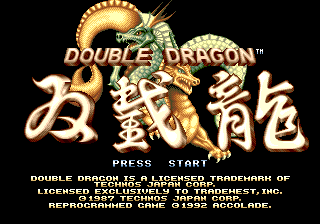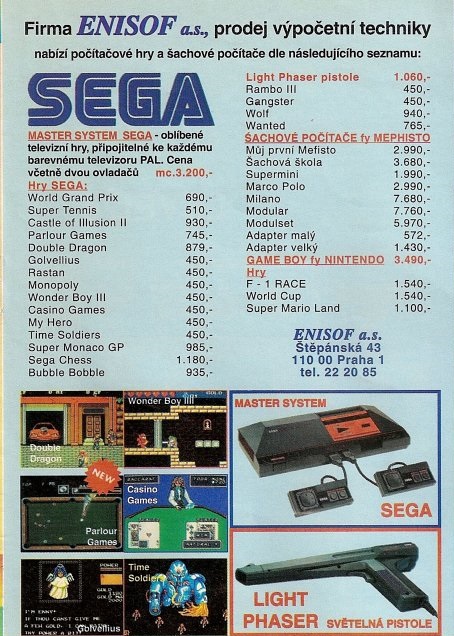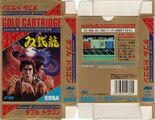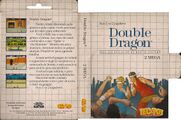Double Dragon
From Sega Retro
- For the 1993 Game Gear game by Virgin Games, see Double Dragon (Game Gear).
| Double Dragon | |||||||||||||||||||||||||||||||||||||||||||||||||||||||
|---|---|---|---|---|---|---|---|---|---|---|---|---|---|---|---|---|---|---|---|---|---|---|---|---|---|---|---|---|---|---|---|---|---|---|---|---|---|---|---|---|---|---|---|---|---|---|---|---|---|---|---|---|---|---|---|
| System(s): Sega Master System, Sega Mega Drive | |||||||||||||||||||||||||||||||||||||||||||||||||||||||
| Publisher: Sega Ballistic | |||||||||||||||||||||||||||||||||||||||||||||||||||||||
| Developer: Arc System Works Accolade | |||||||||||||||||||||||||||||||||||||||||||||||||||||||
| Licensor: Technos Japan | |||||||||||||||||||||||||||||||||||||||||||||||||||||||
| Original system(s): Arcade boards | |||||||||||||||||||||||||||||||||||||||||||||||||||||||
| Developer(s) of original games: Technos | |||||||||||||||||||||||||||||||||||||||||||||||||||||||
| Sound driver: Sound Images v1.0 | |||||||||||||||||||||||||||||||||||||||||||||||||||||||
| Peripherals supported: FM Sound Unit | |||||||||||||||||||||||||||||||||||||||||||||||||||||||
| Genre: Action | |||||||||||||||||||||||||||||||||||||||||||||||||||||||
| Number of players: 1-2 | |||||||||||||||||||||||||||||||||||||||||||||||||||||||
| |||||||||||||||||||||||||||||||||||||||||||||||||||||||
|
Double Dragon (ダブルドラゴン) is a side-scrolling beat-'em-up by Technos released for the arcades in 1987. It's considered a spiritual sequel to Technos's previous hit Renegade, while also serving as a precursor to later games in the genre such as Final Fight and Streets of Rage. The game was ported to several consoles and home computers since its original arcade release, including to Sega consoles twice: the first time was for the Master System by Sega themselves in 1988, and later for the Genesis in 1992 by Accolade.
Contents
Story
Near the end of the 20th century, violence ruled the streets of New York City after the nuclear war and people began forming gangs to survive. On the outskirts of the city lived twin brothers named Jimmy and Billy Lee. The brothers used to run a martial arts school in the centre of the city which was burned down to ashes five years ago as a result of the nuclear war. Despite this, the brothers did not neglect their training for even a day.
The younger brother, Billy, was romantically involved with a female instructor named Marian, but Jimmy was secretly in love with her as well. One day, Marian was abducted by the Black Warriors, a savage street gang led by a man named Willy Mackey. The gang gradually grew in size after the nuclear war and they are now dominant organization of the city.
The Lee brothers set out to confront the Black Warriors and rescue Marian.
Gameplay
Double Dragon is a side-scrolling action game that can be played by up to two players simultaneously. Player 1 controls Billy Lee (who wears the blue outfit), while Player 2 controls his twin brother Jimmy (in red). The objective of the game is to defeat every enemy from one area to the next until reaching the end of the stage and defeating the boss.
The controls of the original arcade version consisted of an eight way joystick and three buttons (kick, jump, punch). The player can move not only left or right, but also towards or away from the background. The basic attacks consists of a left-right punch combo and a kick. After a couple of punches or a single kick, the enemy will be in a stunned pose. During this period, the player can follow it up with an uppercut, a roundhouse kick or a head grab (depending on the enemy type). During a head grab, the player can repeatedly kick the enemy with their knees or throw him to the other side. Other moves including a jump kick, an elbow strike, a leaping reverse kick and a headbutt. Some enemies can also be grabbed from behind during 2-players mode, allowing your partner to attack him.
There are also seven types of weapons that are either, found on the ground in certain areas or by disarming an armed enemy. To pick up a weapon, stand near it and pick it up with the punch button. While armed, the weapon can be used by pressing the punch button. Certain large objects can also be kicked to the ground with the kick button.
Versions
Master System
The Master System version is a downscaled adaptation of the arcade game similar to the NES version released before it. While the character designs are pretty similar to the NES version, the Master System version retains the 2-player co-op mode and features level designs much closer to the arcade game (albeit, without the vertical scrolling and climbable ladders/fences in some areas). Because the arcade version used a three button setup (with a dedicated jump button), the input method of certain moves such as the flying jump kick, backward spin kick and elbow strike were changed to better accommodate the Master System's two button controls. The consecutive attacks (the uppercut and roundhouse kick) and the hair grab are also performed a bit differently. The Master System only displays up to three enemies and a single weapon on-screen at once.
Mega Drive
In contrast, the Mega Drive version is a relatively straight port of the arcade with slight differences in graphics and sound. Most notably the backgrounds graphics are different, some of the character sprites (specifically Marian and Linda) are not 100% accurate and the head-swapped boss characters (the mohawked version of Abobo at the end of Missions 1 and 3, and the Lee brother lookalike at the end of Mission 2) are replaced with plain palette swaps.
Magazine articles
- Main article: Double Dragon/Magazine articles.
Promotional material
also published in:
- Mean Machines (UK) #18: "March 1992" (1992-02-27)[7]
also published in:
- Electronic Gaming Monthly (US) #41: "December 1992" (1992-xx-xx)[8]
Physical scans
Master System version
| Sega Retro Average | ||||||||||||||||||||||||||||||||||||||||||||||||||||||||||||||||||||||||||
|---|---|---|---|---|---|---|---|---|---|---|---|---|---|---|---|---|---|---|---|---|---|---|---|---|---|---|---|---|---|---|---|---|---|---|---|---|---|---|---|---|---|---|---|---|---|---|---|---|---|---|---|---|---|---|---|---|---|---|---|---|---|---|---|---|---|---|---|---|---|---|---|---|---|---|
|
| 75 | |
|---|---|
| Based on 14 reviews | |
| Master System, SE |
|---|
|
Mega Drive version
| Sega Retro Average | ||||||||||||||||||||||||||||||||||||||||||||||||||||||||||||||||||||||||||||||||||||||||||||||||||||||||||||||||||
|---|---|---|---|---|---|---|---|---|---|---|---|---|---|---|---|---|---|---|---|---|---|---|---|---|---|---|---|---|---|---|---|---|---|---|---|---|---|---|---|---|---|---|---|---|---|---|---|---|---|---|---|---|---|---|---|---|---|---|---|---|---|---|---|---|---|---|---|---|---|---|---|---|---|---|---|---|---|---|---|---|---|---|---|---|---|---|---|---|---|---|---|---|---|---|---|---|---|---|---|---|---|---|---|---|---|---|---|---|---|---|---|---|---|---|
|
| 57 | |
|---|---|
| Based on 22 reviews | |
Technical information
ROM dump status
| System | Hash | Size | Build Date | Source | Comments | |||||||||
|---|---|---|---|---|---|---|---|---|---|---|---|---|---|---|
| ? |
|
256kB | Cartridge | |||||||||||
| ✔ |
|
512kB | 1992-01 | Cartridge (US/EU) |
References
- ↑ 1.0 1.1 1.2 Computer & Video Games, "December 1988" (UK; 1988-11-xx), page 175
- ↑ Computer Entertainer, "December 1988" (US; 1988-12-17), page 13
- ↑ Sega Pro, "April 1992" (UK; 1992-03-19), page 9
- ↑ Sega Pro, "May 1992" (UK; 1992-04-16), page 12
- ↑ Sega Power, "April 1992" (UK; 1992-03-05), page 12
- ↑ 6.0 6.1 6.2 GamePro, "March 1992" (US; 1992-xx-xx), page 48
- ↑ Mean Machines, "March 1992" (UK; 1992-02-27), page 66
- ↑ Electronic Gaming Monthly, "December 1992" (US; 1992-xx-xx), page 39
- ↑ 9.0 9.1 Complete Guide to Consoles, "" (UK; 1989-10-16), page 54
- ↑ 10.0 10.1 Complete Guide to Consoles, "Volume IV" (UK; 1990-11-xx), page 95
- ↑ 11.0 11.1 The Complete Guide to Sega, "" (UK; 1991-05-xx), page 55
- ↑ The Games Machine, "January 1989" (UK; 1988-12-15), page 75
- ↑ Player One, "Février 1991" (FR; 1991-xx-xx), page 24/25 (24)
- ↑ 14.0 14.1 Sega Power, "October 1991" (UK; 1991-09-05), page 41
- ↑ 15.0 15.1 Sega Power, "October 1991" (UK; 1991-09-05), page 56
- ↑ Sega Pro, "December 1991" (UK; 1991-11-21), page 45 (47)
- ↑ Computer Action, "Juli/August 89" (DK; 1989-0x-xx), page 34
- ↑ Console XS, "June/July 1992" (UK; 1992-04-23), page 139
- ↑ The Games Machine, "June 1989" (UK; 1989-05-18), page 74
- ↑ Mean Machines Sega, "October 1992" (UK; 1992-09-xx), page 133
- ↑ Player One, "Février 1991" (FR; 1991-xx-xx), page 24
- ↑ Sega Pro, "December 1991" (UK; 1991-11-21), page 47
- ↑ Sega Pro, "April 1993" (UK; 1993-03-11), page 70
- ↑ Tilt, "Mars 1989" (FR; 1989-0x-xx), page 71
- ↑ Consoles +, "Mai 1992" (FR; 1992-0x-xx), page 64-66 (64)
- ↑ GamePro, "March 1992" (US; 1992-xx-xx), page 46 (48)
- ↑ 27.0 27.1 Joystick, "Novembre 1992" (FR; 1992-1x-xx), page 173
- ↑ 28.0 28.1 Sega Mega Drive Advanced Gaming, "November 1992" (UK; 1992-xx-xx), page 79
- ↑ Mean Machines, "April 1992" (UK; 1992-03-28), page 102-104 (102)
- ↑ Sega Power, "June 1992" (UK; 1992-05-07), page 30/31 (30)
- ↑ Sega Pro, "May 1992" (UK; 1992-04-16), page 34/35 (34)
- ↑ Sega Force, "June 1992" (UK; 1992-05-14), page 32/33 (32)
- ↑ 1700 igr dlya Sega, "" (RU; 2001-xx-xx), page 93
- ↑ Console XS, "June/July 1992" (UK; 1992-04-23), page 129
- ↑ Mean Machines: The Essential Sega Guide, "" (UK; 1993-11-18), page 39
- ↑ Game Zone, "May 1992" (UK; 1992-04-22), page 46
- ↑ Joypad, "Novembre 1992" (FR; 1992-1x-xx), page 48
- ↑ Sega Mega Drive Advanced Gaming, "December 1992" (UK; 1992-xx-xx), page 36
- ↑ Sega Mega Drive Advanced Gaming, "January 1993" (UK; 199x-xx-xx), page 91
- ↑ Mega Action, "June 1993" (UK; 1993-05-20), page 64
- ↑ MegaTech, "May 1992" (UK; 1992-04-20), page 52
- ↑ Mean Machines, "April 1992" (UK; 1992-03-28), page 64
- ↑ Mean Machines Sega, "October 1992" (UK; 1992-09-xx), page 138
- ↑ Power Play, "6/92" (DE; 1992-05-13), page 149
- ↑ Sega Power, "June 1992" (UK; 1992-05-07), page 30
- ↑ Sega Pro, "May 1992" (UK; 1992-04-16), page 34
- ↑ Sega Pro, "April 1993" (UK; 1993-03-11), page 65
- ↑ Sega Force, "June 1992" (UK; 1992-05-14), page 32
- ↑ Tricks 16 bit, "Tricks Sega Gold 800 igr" (RU; 1998-03-20), page 52
- ↑ VideoGames & Computer Entertainment, "July 1992" (US; 1992-0x-xx), page 44
- ↑ Video Games, "6/92" (DE; 1992-05-29), page 50
| Double Dragon | |
|---|---|
|
Main page | Comparisons | Maps | Hidden content | Magazine articles | Reception | Region coding | Technical information | Bootlegs | |
| Double Dragon games for Sega systems | |
|---|---|
| Double Dragon (1988) | |
| Double Dragon II: The Revenge (1991) | Double Dragon (1992) | Double Dragon 3: The Rosetta Stone (1992/1993) | Battletoads/Double Dragon: The Ultimate Team (1993) | Double Dragon V: The Shadow Falls (1994) | |
| Double Dragon (1993) | |
- FM Sound Unit-compatible games
- 1-2 player games
- JP Master System games
- All JP games
- US Master System games
- All US games
- EU Master System games
- All EU games
- PT Master System games
- All PT games
- AU Master System games
- All AU games
- BR Master System games
- All BR games
- KR Master System games
- All KR games
- Master System games
- 1988 Master System games
- All 1988 games
- Master System action games
- All action games
- US Mega Drive games
- EU Mega Drive games
- UK Mega Drive games
- All UK games
- Mega Drive games
- 1992 Mega Drive games
- All 1992 games
- Mega Drive action games
- All games
- Old-style rating (cgtc)
- Old-style rating (cgts)
- Old-style rating (cvg)
- Old-style rating (gamesmachineuk)
- Old-style rating (playerone)
- Old-style rating (segapower)
- Old-style rating (segapro)
- Update ratings template
- 9 old ratings
- Old-style rating (consolesplus)
- Old-style rating (gamepro)
- Old-style rating (gz)
- Rating without PDF source
- Old-style rating (joypad)
- Old-style rating (joystick)
- Old-style rating (mdag)
- Old-style rating (megaaction)
- Old-style rating (megatech)
- Old-style rating (mm)
- Old-style rating (sfuk)
- 13 old ratings
- Old technical information
- Double Dragon
- Double Dragon (franchise)
















